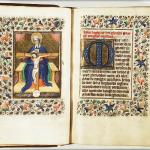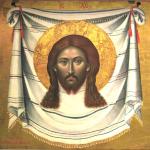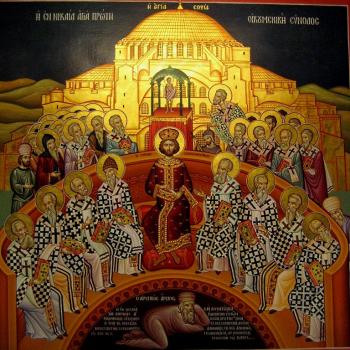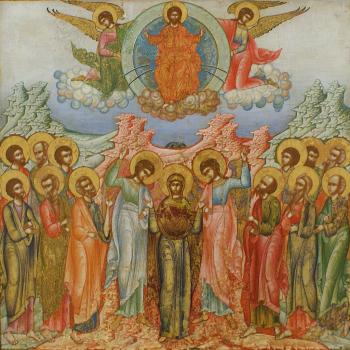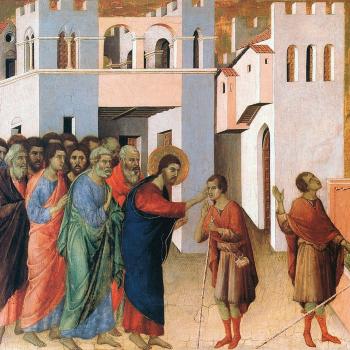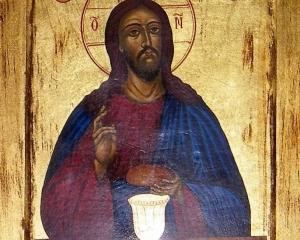
The eucharist is the real, sacramental presence of Jesus. The real presence is not about how Jesus comes to us, giving us a mere portion of his flesh and blood (infused with his soul and divinity). Communion should not be overly simplified in this fashion. Sadly, because of the way it is often taught in popular literature, many Catholics and non-Catholics misunderstand the real presence, thinking it implies that communion gives the faithful some physical portion of Christ’s body. This leads to all kinds of erroneous notions about the eucharist. People are led to think of the sacramental presence in a physical way, that what is had might appear to be bread and wine but is physically, behind that appearance, flesh and blood. This is often reinforced through the way eucharistic miracles are portrayed, where the eucharist, for one reason or another, no longer comes under the appearance of bread and wine but under the appearance of such flesh and or blood. Many Catholics think the appearance of bread and wine are a kind of illusion, and when eucharistic miracles show some flesh or blood, they represent what the eucharist really is. The truth is something far different. The accidents, the physical qualities, should not be seen as illusions, as if a magic trick was being done. They are not illusions. They have real empirical qualities which we interact with, while illusions, on the other hand, would be mere phantasms with no empirical reality to be engaged. We have more than an appearance of bread and wine (or flesh and blood, in eucharistic miracles) for we also have the physical qualities associated with those appearances. Nonetheless, the essence of what is received is not what is found in the accidents, that is in the sensible, physical form which is before us, but rather, it is Jesus as he is in his whole person. The faithful, in partaking of communion, are not eating a piece of his flesh, or drinking some of his blood; they are, instead, receiving the sacramental and so real presence of the person of Jesus, a person who brings with him all that he is in that presence.
It is important for us to understand that the accidents, the physical form, is not what the eucharist essentially is, whether or not they appear as bread and wine, or through some eucharistic miracle, as flesh and blood. And indeed, the bread and wine are not to be understood as mere illusions which hide some piece of flesh and blood, making it so we can consume what we would otherwise find difficult to consume. For, if it were merely flesh and blood, communion would be about taking a part of Christ’s body instead of the fullness of who and what he is as a person. It is with this understanding that St Thomas Aquinas said:
For we do not claim that the Body of Christ is cut to pieces and thus divided is eaten by believers under the Sacrament, so that at some point the supply must fail, even if it have the magnitude of a mountain, as they say. [1]
The eucharist, therefore, is not some portion of the body or blood of Christ given to the recipient. It is the fullness of Jesus, not a part of Jesus. It is described, theologically, as the “sacramental presence” because it is understood to be something different from a mere physical presence, the kind which many wrongly equate with communion, the kind which would ultimately lead people to think Christ’s body is being divided into parts. What we receive is the presence of Jesus in his fullness, a fullness which includes all, not just a part, of his body, a presence which we partake of and use to bring him into ourselves (and similarly, to let ourselves be brought in and united with Jesus and therefore incorporated into his mystical body).
Pious believers often describe the eucharist as being the body and blood, soul and divinity of Jesus Christ. In the sense that they receive all that Jesus is in and with the eucharist, this is true. However, they must remember, Jesus ascended into heaven, and his body was transformed and spiritualized. His body, and with his, his flesh and blood are spiritualized, and so no longer are to be understood as being mere empirical (physical) realities, realities which allow them to be cut up into parts. Jesus’s body has gone from a physical, empirical mode of being to that of a spiritual mode of being, making it a “spiritual body.” It is the same body, not a different one, to be sure. Since it came from material creation, it is still connected to the material world, even though it is has become spiritualized. That connection will never be lost, but rather, it is this connection which will help lead all material being to also be spiritualized along with it, taking all that is in temporal history into eternity to find its proper place in the eschaton. What happens in the world, what happens in time, is important, for it will serve the basis for the spiritual form it will take in in eternity. What happens in time and space matters; any misunderstanding of the ascension where one thinks it means Jesus has abandoned material creation, leaving it behind, does not understand the ascension and the spiritualization which took place: the spiritualization allows for Jesus’s presence to be attained throughout the world instead of merely one material location.
Matter and spirit are interconnected. The eucharist, as with all the sacraments, are representations of this. They have a physical component to remind the faithful that physical, material creation has a place in eternity, that it will be spiritualized in eternity, providing it its final mode of being. We can understand this transformation as a kind of growth, so that, just as we do not think an infant is different from the adult, despite the transformation which takes place, so we do not think the spiritualized person, with their spiritualized matter, has a different body than what they had in their materialized form. With the eucharist, the faithful partake of the fullness of Christ, so that they receive him into themselves, allowing Jesus to join himself with them, to bring them grace, but in doing so, they also open themselves up to being taken in by Jesus, to be assumed by him, so that they become a part of his mystical body, and in this way, the two become one, a truth which is hinted at in when two lovers unite and become one.
The earthly, material form of communion, no matter how it appears, whether it is as bread, wine, flesh and or blood, only points to (and so symbolizes) what is being partaken. For what is received is Jesus; he comes to us as spiritual food and drink. He offers us all that he is. Whatever Jesus incorporated into himself thanks to the incarnation is a part of what is received in communion. As the eucharist has the one who partakes of it join in and become a part of the body of Christ, it can even be said that through communion, the faithful even receive themselves, and it is in and through this, they can become their true selves. In this way, communion, helping us become our true selves, also has us become truly alive, which is why Jesus said that he is the living bread which we must partake of if we are to truly be made alive :“I am the living bread which came down from heaven; if any one eats of this bread, he will live for ever; and the bread which I shall give for the life of the world is my flesh” (Jn. 6:51 RSV). Now, to be sure, the grace of the eucharist, the grace of communion, is the point of the reception, and though the normative way of receiving Christ for this grace is in and through communion, but it is not the only way. Indeed, as an example of this, Bulgakov pointed out that the real presence of Jesus can be experienced in prayer (which is not to say we should ignore the sacramental presence, but instead, understand how Jesus can and will have many ways to help those who, through no fault of their own, do not have the means to receive the eucharist and yet will receive all that it entails and so be saved):
The Lord is life and grants the faithful to partake of Him daily and hourly. Day after day of life is this bread given to us, and we rejoice and live in it. This bread is the Lord, giving Himself in Holy Communion, in prayer, and in His holy Name. All you who pray and invoke His name with your whole heart, know that you commune in His holy name, that you taste the bread of life through the power of this invocation. He abides in you and you in Him [cf. John 15:4]. Not by measure does God give His Spirit [John 3:34], and there exists communion in the Body and Blood, but there is also communion in the Name. For prayer is always a union with Christ, by which the power of Christ enters into us. [2]
The fact that the eucharist must not be confused with the outward sign, that is, what is seen and experienced with the empirical senses, is something which must be emphasized again and again, both to Catholics and to non-Catholics alike. For, it is clear, many Catholics, though believing correctly that the eucharist is essentially Jesus, nonetheless misunderstand the sacramental presence, confusing it with a mere physical presence. They end up essentializing the accidents, turning communion into a purely physical engagement with Jesus. This is why so many of them think there is nothing symbolic connected with communion, ignoring the great Catholic tradition which points out all sacraments, especially the eucharist, come to us in a symbolic form to represent the reality which transcends not only our empirical senses, but our comprehension as well.
Eucharistic miracles should not be used to make people think the eucharist is merely physical flesh and blood, parts taken from a body. It isn’t. Christians are not cannibals. They partake of Christ, even as at the same time, Christ partakes of them. This mutual engagement and partaking of each other allows them to become one, so that the faithful becomes one with and a part of the mystical body of Christ, the body which has been spiritualized and is now working for the spiritualization and glorification of the whole world. Thus, what happens in the liturgy is that we find material bread and wine are taken in by Christ and are transformed, through the work of the Spirit, so they become incorporated into him (similar to the way one who eats bread or wine has the food they eat become a part of their own body, though the difference, of course, is that in communion, there is no waste, and also, in the incorporation into the body of Christ, what is taken in is transformed into the body of Christ, not destroyed or annihilated). And, once again, again, what they become is not just mere flesh and blood, but all that Christ is in his person.
The interdependent connection between matter and spirit, previously mentioned, is best represented to us, whose senses perceive empirical reality more than spiritual reality, through some physical means. This is why the sacraments must contain a physical element even if the reality contained in them, when they are given, is no longer merely what is seen by those physical elements (such as happens with communion). The physical world and all that is in it was created good and has a place in the eschaton. The so-called Gnostics were wrong in rejecting matter. It is a part of who and what we are, and even when it is spiritualized, it will always be a part of who and what we are, even as Jesus’ body, though glorified and spiritualized, is the same body as he had in his temporal ministry. The transformation which takes place with the sacraments is real, and not some sort of magic trick, even if God does preserve the accidents (physical form) in order to have us have some sort of physical way to engage the sacraments and all that they shall bring, as Aquinas also indicated:
Nor, moreover, do we say that this comes to be as though the species in the sacrament of the Altar which appear to the senses exist solely in the imagination of the beholders, as happens with magic tricks, because no fiction is becoming to the Sacrament of truth. But God who is the Creator of substance and accident can conserve the sensible accidents in being, their subjects having been transmuted into something else. [3]
Thus, if there is to be a better understanding of the eucharist, one which will help the faithful come to better terms with it and its value, we must do so in a way which presents its spiritual reality and does not limit it to its empirical form. The faithful must be brought to an understanding of its mystical nature, and with this, to understand the symbolic elements of communion (and all the other sacraments as well). It must be made clear that they are not partaking only of some part of his flesh and blood; instead, it should be shown how they truly receive Jesus in his fullness, and so, they receive a mystery which transcends all potential empirical explanations. The appearance of the eucharist is symbolic, pointing to its greater reality in one form (bread as food) or another (flesh and blood pointing to the humanity of Christ). This is why it is wrong to deny that the eucharist is a symbol, for how can it not be when what it is is more than what we see? It is, of course, not a mere symbol without the reality behind the symbol, but rather, it the symbol which presents the reality of what is symbolized with it. Once this is understood, Catholics will be able to better address non-Catholic misunderstandings of the eucharist, ones which has them think Catholic teaching indicates some form of cannibalism. Since what is eaten is not some physical flesh and blood, but rather, the sacramental presence of Jesus, there is no cannibalism involved. Then, it will be easier to show that communion brings people into a mystical union with Christ, allowing them, then, to also become a sign and symbol of Christ to the world.
[1] St. Thomas Aquinas, On Reasons for Our Faith Against the Muslims, Greeks, and Armenians. Trans. Peter Damian Fehlner (New Bedford, MA: Franciscans of the Immaculate, 2002), 54.
[2] Sergius Bulgakov. Spiritual Biography. Trans. Mark Roosien and Roberto J. De La Noval (Brooklyn, NY: Angelico Press, 2022), 143 [25.IV/ 8.V.1925].
[3] St. Thomas Aquinas, On Reasons for Our Faith Against the Muslims, Greeks, and Armenians, 55-6.
Stay in touch! Like A Little Bit of Nothing on Facebook.
If you liked what you read, please consider sharing it with your friends and family!
N.B.: While I read comments to moderate them, I rarely respond to them. If I don’t respond to your comment directly, don’t assume I am unthankful for it. I appreciate it. But I want readers to feel free to ask questions, and hopefully, dialogue with each other. I have shared what I wanted to say, though some responses will get a brief reply by me, or, if I find it interesting and something I can engage fully, as the foundation for another post. I have had many posts inspired or improved upon thanks to my readers.


